Toes need room
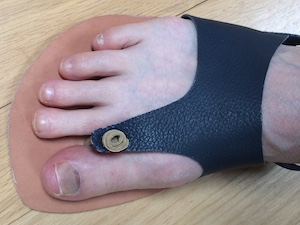
Toes in footwear that allows them to move and spread.
My toes are the reason I started making my own footwear. I was catapulted into action by a big toe joint that was suddenly excruciatingly painful. All my shoes seemed to aggravate the pain, as did every new pair I tried.
I eventually realized they all had tapering shapes that pulled my big toe towards the center line of the foot.
In desperation, I decided that if I couldn’t buy shoes to fit, I would have to make them. I also started wearing toe socks.
Thanks to these changes, my feet are now pain-free.
Issue 1: painful joints, and bunions!
One evening in late 2014, the joint at the base of my big toe on my right foot swelled up and started throbbing. It was bright red, and hot to the touch. I had trouble sleeping that night. The following morning, walking hurt. Over the next few weeks, the pain worsened despite over-the-counter painkillers, so I hobbled off to a podiatrist.
X-rays showed that I had lost cartilage in part of the swollen joint. Diagnosis: osteoarthritis. And to cap it off, I also had bunions starting to grow on both feet.
I was horrified: how had it got to this point without me noticing? And how could it be resolved? For the osteoarthritis in the joint, the podiatrist prescribed anti-inflammatory medication and rest. She put my symptoms down to genetics (my mother has bunions), encroaching middle age (!) and previous athletic injury (I used to play soccer). As for a cure, she told me I would likely be taking daily painkillers for long periods and would eventually need an operation on the joint when painkillers no longer sufficed.
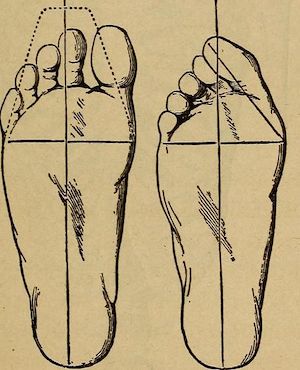
To the left is an undeformed foot. To the right is what my foot was starting to resemble: the big toe was being pushed towards the center- line of the foot by my footwear (see the dotted outline on the left-hand image). This illustration comes from a book published in the 1880s: shoemakers have known for centuries that footwear can deform feet.
Medicine and inactivity did not appeal to me at all. I have always been very physically active, and was very unwilling to take daily medication unless absolutely necessary. After about a week of the high-strength painkillers, my feet didn’t hurt when I went barefoot, but began throbbing again the moment I put socks on, let alone shoes. Surely this could not be a coincidence?
I did some research. Thanks to the internet, it didn’t take long for me to come across Katy Bowman’s book on healthy feet. A lot of her conclusions and advice made sense to me. In essence, the toe shapes of my footwear were pushing my big toe joint out of alignment. (Same for my little toes; although they weren’t hurting yet, I could see that they were seriously misaligned).
The front parts of all my footwear were tapered enough to be jamming my toes towards the center-line of my foot. As a result, the cartilage which should protect the bone surfaces had been partly worn away in my right big toe joint. Hence the osteoarthris (ouch!).
What’s more, the toes were starting to stay out of alignment even when not wearing footwear. Hence the bunions.
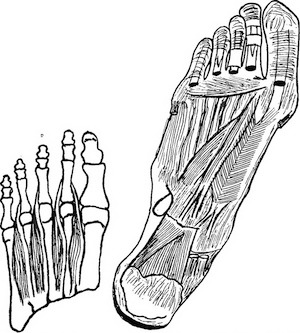
Bones in the toes should be lined up with bones in the main part of the foot, as on the left. But footwear can force the big toe over, deforming the foot, and pinching the nerves, as illustrated on the right. Illustration from the 1920s.
I needed to get my joints back into alignment: the bones in the big toe needed to line up better with the bones in the main part of the foot.
In her book, Katy Bowman recommended stretching exercises, attention to gait and selection of footwear that doesn’t push toes together. The first two were easy to achieve. The third was not.
Issue 2: long middle toes
The second and third toes on each of my feet are marginally longer than my big toe. This foot shape is not unusual: a substantial minority of the population has these long middle toes. There are so many of us that there is even a name for this condition: Morton’s Toe.
For as long as I could remember, the nails on my second and third toes often turned black when I had been running or playing some kind of sport (while wearing shoes, of course). I had mostly ignored the issue. But after my joint pain developed, I decided that ignoring was not the best strategy for long-term health. I want my feet to let me be active as long as the other parts of my body allow. Having being diagnosed with osteoarthritis and bunions, I didn’t want other problems, like hammer toes, to creep up on me unawares.
Issue 3: numb toes
Once I found out I had bunions starting, I started to stretch my toes apart a few times a day, to try to strengthen my toe muscles and get the toes back into alignment with the bones in the ball of my foot.
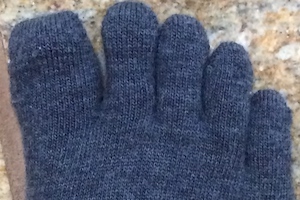
Toe socks let the toes move separately from each other: as if you were barefoot. They also don’t pull the big toe out of alignment, or cause long second toes to curl inwards like many conventional socks do.
When I did this, I was very disturbed to find that that the inside of each of my big toes seemed more-or-less numb. I could just about sense pressure in this area, but had no fine feeling at all.
Barefoot solution to all 3 problems
I spent roughly a month at the end of 2014 going barefoot whenever possible. My feet did not hurt at all when they were bare. But it was an extremely cold winter my part of the world, so my feet were always chilly even indoors. How could I get the barefoot experience without actually being barefoot?
Toe socks
Whenever I put on conventional socks, even soft wool ones, I can feel my toes being pulled together. So I decided to try toe socks instead.
I have now been wearing Injinji wool toe socks since early 2015. I have found them extremely comfortable in summer as well as winter. They accommodate my long middle toes. They let my toes separate from each other. When my foot moves, they allow my toes to move in correct alignment with the underlying joints, just as when I am barefoot. I love them.
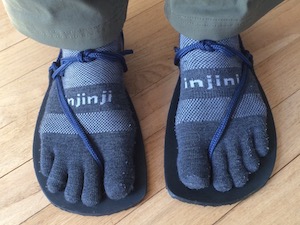
Toes with room to spread in a home-made pair of huarache sandals. The hard-wearing sole comes from a kit made by Xero Shoes. I bought a size several sizes too large and chopped it down so the toe area was wider than the ball of the foot. Note the asymmetric shape: the sole is longest on the inside of a line drawn down the center of the foot.
Roomy toe shapes
I needed shoes and boots that didn’t squash my toes together. I especially wanted to avoid anything that pushed my big toe towards the center-line of my foot.
Easier said than done: at the time, the only shoes with wide-enough toes for me were Birkenstocks, orthopedic shoes, and Altra Running sports shoes. And in most of the styles that were broad enough in the toes, my heels slipped up and down (blisters, ouch!). What’s more, the soles were either too stiff or too cushioned to let my foot move as naturally as I would like. And I don’t think of myself as a slave to fashion but the orthopedic shoes were truly hideous to behold.
So, with literally no shoes that fitted other than one pair of luridly-colored Altra Running shoes, and having spent hundreds of hours and a ridiculous amount of money trying to find shoes to buy, I decided it would be quicker and cheaper for for me to make my own.
It’s like being barefoot: hurrah
Now, my feet can move naturally inside my footwear, almost as if I am barefoot. For the first time since early childhood, I am not getting black middle toenails after going for a long run. The big-toe numbness has disappeared. My big toe joints are no longer swollen and painful. And, almost a decade later, my bunions have shrunk to nearly nothing.
Unbound feet change shape, naturally
Interestingly, in the years I have been wearing footwear with ample toe space and zero-drop, flexible soles, my feet have changed shape, to the extent that I can no longer comfortably wear the first several pairs of shoes I made myself… despite the fact that I made them exactly to fit at the time. My toes have spread and become more muscular now that they are habitually less confined. My arch is higher, and so is the point on the foot above the arch. I have transitioned to a more natural foot shape.